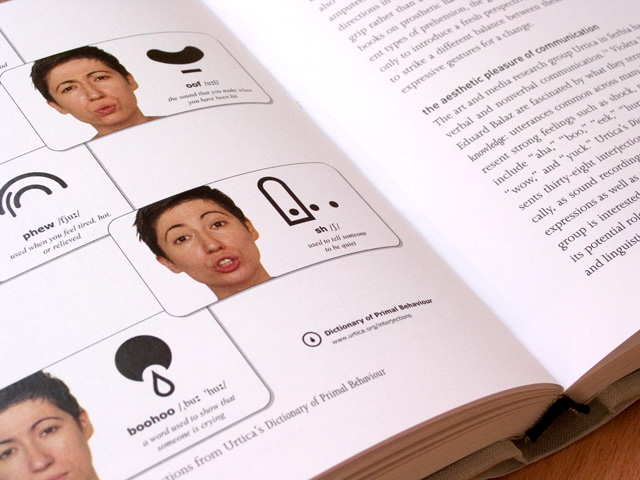
|
Dictionary of Primal BehaviourInternet Database and Digital Prints
|
- Photo doc
 Essay:
Essay:
The Primal Chat- + more
 Excerpt from Graham Pullin's book
Excerpt from Graham Pullin's book-
Art and Language
A database of phonetically expressive words transferred into visual codes
-
Keywords / Tags
- Database art,
- Language,
- Entropy,
- Primary emotions,
- Emotion,
- Expression,
- Facial expression,
- Affective communication,
- Dictionary,
- Interjection,
- Nonverbal,
- Code,
- Information,
- Message,
- Symbol,
- Meaning,
- Aesthetic communication,
- AAC - augmentative and alternative communication,
- Disability
Art-Bio:
Awards
- 2003
- UNESCO Digital Arts Award 2003 at IAMAS, Japan
- Award at “MAD 03” 2nd meeting of experimental art in Madrid, Spain
- The annual award of the gallery Golden Eye “The exhibition of the year”, Novi Sad, Serbia and Montenegro
Festivals and Group Exhibitions
- 2004
- Ogaki, Japan, Ogaki Biennale 2004, (IAMAS)
- 2003
- Holon, Israel, “Hilchot Shchenim”, The Israeli Center for Digital Art
- Basel, Switzerland, “Viper”, International Festival for Film, Video and New Media, Basel
- Belgrade, SCG, “WLI” World, Language, Iconicity - group exhibition and symposium, Rex B92 Cultural Center
- Madrid, Spain, “MAD 03” 2nd meeting of experimental art in Madrid
- Belgrade, SCG, “POSITIVE / NEGATIVE”, 44th October Salon
- Novi Sad, SCG, “Balkan video&digital art Festival”, solo exhibition at Gallery Golden Eye
- Linz, Austria, “CODE”, Ars Electronica
- Sao Paolo, Brazil, “FILE 2003”
Graham Pullin, “Design Meets Disability”, The MIT Press Massachisetts Institute of Technology Cambridge, Massachusetts
“The easthetic pleasure of communication”
Fragment of a book “Design Meets Disability” by Graham Pullin; MIT Press [2009],
chapter Expression meets information [pages: 170, 171, 173]
The art and media research group Urtica in Serbia bridged verbal and nonverbal communication. Violeta Vojvodic and Eduard Balaz are fascinated by what they term common linguistic knowledge: utterances common across many languages that represent strong feelings such as shock, pain, or pleasure. These include “aha,” “boo,” “eek,” “hurrah,” “oh,” “oops,” “ow,” “wow,” and “yuck.” Urtica’s Dictionary of Primal Behaviour represents thirty-eight interjections both phonetically and graphically, as sound recordings, photographs, and videos of facial expressions as well as graphic icons abstracted from these. The group is interested in the redundancy of this technique, and its potential role to accommodate disability as well as cultural and linguistic differences between speaker and listener.
But Urtica is also intrigues by ambiguity and the room left for interpretation. It cites French information theoretician Abraham Moles’s theory that aesthetic pleasure is determined by the balance of originality of the message and the ability of the recipient to understand it. Clearly intonation plays a role on both sides of this equation: it helps decipher meaning, but just as important, it affords more originality of expression. At the moment, it seems that AAC (Augmentative and Alternative Communication) is more concerned with the understanding then expression.
The Dictionary of Primal Behaviour is described as an art project, and not only is aesthetic pleasure a theme of research, it also manifest in its presentation. If this level of design were routinely brought to AAC, devices would be more satisfying to use, but also send out more positive signals about their users to others. Too often communication aids designed for adults look as though they are intended either for young children or computer programmers. In our culture we take for granted a visual sophistication in most things. How much more appropriate to find this in something as profound as a communication aid.
Graham Pullin is a lecturer in Interactive Media Design at the University of Dundee. He has worked as a senior designer and studio head at the design consultancy IDEO.
Research Projects of Graham Pullin:
+ https://www.dundee.ac.uk/people/graham-pullin
Book “Design Meets Disability,” MIT Press:
+ https://mitpress.mit.edu/books/design-meets-disability

 People of Europe, Guard Your Precious Values
People of Europe, Guard Your Precious Values The Art in Liquidation
The Art in Liquidation Art and Crisis - Facing Bureaucrat (video)
Art and Crisis - Facing Bureaucrat (video) VQ Bourse - The Value is Here
VQ Bourse - The Value is Here VQ - Art of Fortune and Economy of Risk
VQ - Art of Fortune and Economy of Risk VQ - Golden Card
VQ - Golden Card That Which Changes
That Which Changes Who is Guarding the Guardians?
Who is Guarding the Guardians? Social Engine
Social Engine Dictionary of Primal Behaviour
Dictionary of Primal Behaviour Lapsus Memoriae
Lapsus Memoriae Kumova Sekira
Kumova Sekira Omnigenus
Omnigenus Urtica Medicamentum Est
Urtica Medicamentum Est Social Engine - The Hybrid Source Book
Social Engine - The Hybrid Source Book
